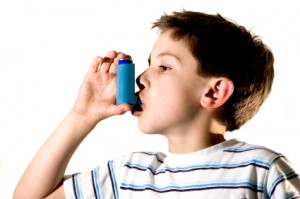 Longer, hotter summers predicted by climate change models won’t affect the respiratory health of Manitobans on their own. Rather, it is the deadly combination of increased sunshine, heat, and common pollutants that will take our breath away.
Longer, hotter summers predicted by climate change models won’t affect the respiratory health of Manitobans on their own. Rather, it is the deadly combination of increased sunshine, heat, and common pollutants that will take our breath away.
On this page we deal with these respiratory issues:
- Ozone
- Particulate matter
- Air pollution and heat
- Young lungs
- Sick will get sicker
- Breathing in brake pads
Cars and other motorized vehicles produce the majority of greenhouse gas pollution in Manitoba – 38% of total emissions by sector (1). The major emissions from automobiles not only contribute to climate change, but also represent a serious health risk to Manitobans.
The combustion of fossil fuels produces a cocktail of greenhouse gases (GHG’s) that trap heat in the atmosphere and cause global warming. Cars also emit several pollutants that are classified as “toxics”. These cause as many as 1500 cases of cancer annually (2) and aggravate respiratory and heart conditions.
Click here to learn more about tailpipe emissions.
Ozone
Nitrogen oxides (NO and NO2) and hydrocarbons (HC), are produced from the combustion of fossil fuels. When mixed with other volatile organic compounds (VOCs), these common pollutants set the stage for ground-level ozone production. Solar energy – sunshine – is a catalyst for the chemical reactions that produce ground-level ozone.
Ozone irritates and inflames the respiratory tract (3). It is especially harmful to Manitobans with existing respiratory problems. Ozone may become even more harmful when combined with common urban pollutants such as acids, pesticides, chlorofluorocarbons, and metal aerosols (4)
At least half of Canadians are already exposed to unacceptable levels of ground-level ozone during the summer months (5).
Particulate matter
Particles generated by burning fossil fuels enter deeply into lungs and adhere to tissue. This aggravates asthma, causes respiratory illness, and sometimes causes premature death.
Air pollution and heat
Climate change models predict hotter summers for Manitobans. Cities, simply by virtue of having many buildings made of concrete, are already hotter than the surrounding countryside. This is known as the urban heat island effect.
Unfortunately for city dwellers, extreme heat and air pollution have a synergistic effect (6). With extreme heat, pollution levels that would not otherwise cause respiratory failure suddenly become dangerous (7). Coupled with increased lung-irritating ozone levels, hotter summers in the city may be hazardous to our health.
Young lungs
Children are especially at risk for respiratory problems brought on by climate change conditions.
- They typically spend more time outdoors, and are more likely to be exposed to harmful ground-level pollution.
- Small bodies also require more air per kilogram of body weight. Children will inhale a greater proportional volume of polluted air than adults.
- Young Manitobans are still growing. Their developing lungs are more sensitive to irritants. Studies show that children exposed to air pollution lose some of their lung function (8).
Sick will get sicker
People with chronic cardiac and pulmonary illnesses are also predicted to suffer more under the impact climate mediated air pollution (9). This includes people with a heart condition and those with emphysema, chronic brochitis, allergy problems and asthma.
About 7% of Manitobans have asthma (10). Ozone has been implicated as a bronchoconstrictor, causing airways to shrink or close, precipitating a deadly asthma attack (11). The link between high ozone levels and hospital admission rates for asthma is well-known and well-documented (12).
Breathing in brake pads
Manitobans with respiratory illnesses have further reason to reduce the use of greenhouse gas-spewing automobiles. Motorized vehicles produce tiny particulate matter from emissions and mechanical wear, such as the breakdown of brake lining or rubber tires.
Asthmatics are especially sensitive to fine particulate matter in the air (13). Tiny, respirable particles (less than 10 micrometers – PM10) are not filtered out by the defenses of the respiratory tract and are inhaled directly into the lower airways (14). These microscopic bits of metal, rubber and burnt gasoline induce asthma attacks by adhering to, and irritating, the delicate tissue of the lungs.




